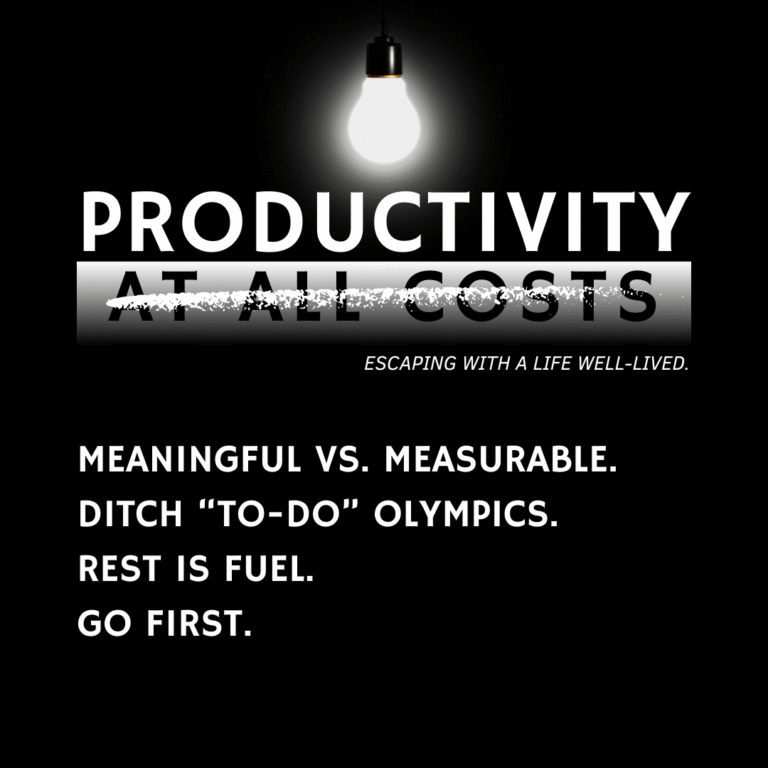
The Lie of “Growth at All Costs”
You’ve probably heard of “growth at all costs” — the darling mindset in Silicon Valley boardrooms and Wall Street war rooms. It’s the belief that if you just scale fast enough, hire quick enough, and spend recklessly enough, the growth will take care of everything else. (Spoiler alert: it rarely does.)
After watching several very large companies spectacularly implode in recent years (just Google WeWork), many of us are waking up to the realization that this model has some… downsides, to say the least. Like employee burnout, ethical compromises, or that minor issue where you accidentally collapse the entire company when investors realize your performance doesn’t outpace your erm, pace?
The Rise of “Productivity at All Costs”
And while this is a mindset to beware of, I believe there’s an even sneakier version flying under the radar. It’s not a business strategy. It’s a personal one. And what’s worse is if you pick a department, a vertical, a company, a location…it’s likely there in force.
Let’s call it “productivity at all costs.”
The Invisible Pressure to Always Do More
You know the feeling, don’t you?
That subtle pressure at the end of the day whispering, “You didn’t check enough boxes today.”
The very real compulsion to add an already-completed “to-do” to your to-do list… and then immediately cross it off for the quick rush of endorphins.
The constant scanning of your own energy like your laptop’s energy-saver mode at 5% battery: “Is this activity valuable?” “Am I optimizing my time?” “Should I even be watching this show without folding laundry?”
Caught in the Loop
Welcome to the vicious loop. Today, it’s not just hustlers and executives feeling this pressure — it’s all of us. You name the platform and you’ll find content that feeds that beast, driving you to be more productive. We’re caught between wanting rest but fearing laziness, craving creativity but measuring everything against “value add.”
If that’s you, first: you’re not alone. After all, I’m sitting at my desk in this moment, sipping an energy drink while surrounded by a million to-do’s, struggling to find the focus to write. So I’m with you.
Second: take a deep breath. There’s hope.
Why We Feel This Way
For starters, the system isn’t built in our favor and knowing that is half the battle. “Productivity at all costs” has been a mindset in the making since the early 1900s with the advent of modern manufacturing and productivity culture. The OG industrialists wanted to develop a system that pushed maximum output. And it’s not rocket science. Maximum optimization and efficiency look more financially beneficial than creativity, rest and general well-being. But what about it’s effect on people? Is this a sustainable system?
A 2023 study by Deloitte found that 60% of employees feel that their mental health is negatively impacted by always needing to be productive, and nearly half say they don’t feel like they can disconnect — even when they’re off the clock (Deloitte, 2023). And in 2024, Mercer assembled their Global Talent Trend Report that showed as much as “82% of the workforce is at risk of burnout”. The cause? “Excessive workload, exhaustion, and financial strain.” (Mercer, 2024)
It’s Not That We’re Weaker — We’re Wiser
While some might disagree, I don’t believe this is a new result we are seeing due to today’s generations being weaker or less resilient. Instead, I would propose it’s because society is more open to admitting there’s a problem, younger generations are better at talking about the problem more openly, and we have global information networks with which to share a reality that’s always been lurking.
Productivity Isn’t the Enemy — But It’s Not Your Identity
Let’s be clear, I’m not saying productivity is evil. Who doesn’t love a well-organized calendar and clear to-do list. But when the relentless drive to be productive becomes your core identity, the goalpost will forever be in motion. The result? You never feel “done.” You never feel “enough.” And you live your life in a toxic cycle of trying to find the end of your to-do list so that you can finally relax. So, where do we go from here?
Escaping the Productivity Trap (Without Moving to a Remote Island)
Here are a few gut-checks and gentle shifts to help:
Ask yourself: Is this meaningful, or just measurable?
Not everything worth doing fits neatly on a spreadsheet or in your Notion planner. Taking a walk, calling a friend, sitting quietly — these aren’t “wasted time,” they’re life.
Ditch the “To-Do List” Olympics.
You don’t need to prove your worth with task volume. Your value isn’t tied to productivity output. It’s okay if your list says: “1. Breathe. 2. Drink coffee. 3. Be a human.”
Redefine rest as fuel, not failure.
Rest is not the opposite of productivity — it’s part of it. A well-rested brain is a creative one. Give it some credit. Your family will benefit, and your boss and coworkers will (or should) too.
If you’re a leader — go first.
Model boundaries. Take your vacation. Log off when the workday ends. Wait to send that email until Monday. Show your team that being effective doesn’t mean being endlessly available.
This isn’t a call to give up ambition or abandon discipline. It’s a reminder that you are a person — not a machine — and you deserve a life that’s lived, not just optimized.
So maybe start by putting “LIVE LIFE” at the top of your to-do list as a not so subtle reminder to truly prioritize. Then cross that off your list. Or don’t.
Author’s Note: Parts of this article were researched, drafted, and enhanced with the assistance of artificial intelligence (AI) tools, including ChatGPT. All information has been reviewed and edited by the author for accuracy, tone, and clarity. The use of AI supports the creative process, but the ideas, perspectives, and final voice are entirely my own.
